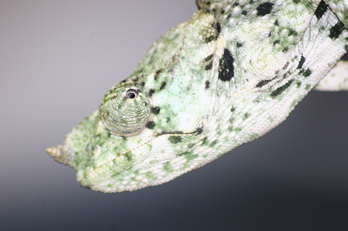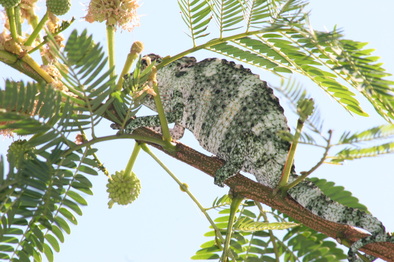Trioceros melleri

The largest of the trioceros species, and one of the more widely available, Meller's chameleons are often bought on impulse due to their large size and showy coloration. These chameleons can reach up to 24 inches, and are SOLID. They are considered the largest of the African chameleons. Mellers chamleons can be found in Kenya, Mozambique, and Tanzania, different localities exhibit different coloration, and some are larger than others. In African folklore it is believed that the mother chameleon climbs high into a tree, lets out a loud howl, and jumps down, releasing her young. Obviously this is untrue, especially since mellers chameleons are oviparous and lay eggs. Unfortunately, most meller's come in as imports with a heavy parasite load. Many have dubbed them the "90-day chameleon" because imports with heavy parasite loads usually don't last more than 90 days. Luckily in the past few years several captive hatched and captive bred specimens have been produced. When properly established and acclimated, mellers chameleons are quite hardy, accepting a wide variety of foods, including greens. The only downside to this species is the large caging requirements, despite this species not being very active, they like a lot of room.
Captive Care
Choosing Your Chameleon
A good percentage of mellers chameleons you will find in pet-shops are wild-caught. When choosing a wild caught there are a few things to look for. Make sure the chamelen is alert and well-hydrated, meller's chameleons drink a lot. A lot of times the rostral horn will be absent due to stress. When cramped they will rub off their horn from trying to escape. If possible try to buy younger imports, they acclimate much better to captivity, and you will get to see the chameleon grow. Overall, younger imports are much healthier, and are a better choice. Upon bringing your new chameleon home, the first priority should be hydration. Give your chameleon about 15-40 minutes of drinking opportunity, whether this is done in the shower (with the head facing the wall so the chameleon is pounded with water, but gets what bounces off), or a long misting. Meller's chameleons have small kidneys so they need to drink a lot.
The Basics
Meller's chameleons need large enclosures, or free ranges. Like most other trioceros, they require lots of water, so proper drainage is necessary. Meller's chameleons should have an ambient temp of 68-75 degrees, with a basking spot of 85-90. These chameleons like to bask, but it is important to give them a cooler retreat. Three, three to five minute mistings a day is idea for mainting a healthy, hydrated chameleon. With new imports they will most likely require longer, more frequent mistings.
Housing
Meller's chameleons like their space. The bare minimum for a single adult chameleon would be a 2x2x4 vertically oriented screen cage. One upside to Meller's chameleons is that they can be housed in groups. Although they can be housed in cages, most Meller's prefer to be free ranged, or atleast have large cages. An ideal enclosure for a group of two melleri would be a heavily planted 6x6x7 enclosure. I personally only keep juveniles in 2x2x4's. Proper drainage is necessary due to this species water needs (due to their small kidneys).
Diet
Meller's chameleons require suitably sized feeders, due to their large size. A large part of my chameleons' diet consists of wild caught insects. This includes, katydids, grasshoppers, mantids, etc. When collecting wild insects it is important to be farmiliar with the species (and that it's not toxic) and that they are collected from pesticide-free areas. For Meller's chameleons, the only commercially available insects in my opinion that are suitably sized are certain roach species, hornworms, and silkworms. Despite their size, Meller's chameleons also enjoy the occasional blue-bottle fly for stimulation. Wild insects are the best thing for a chameleon because they have been in the wild eating what they should be, when they want to, making them have a rich gut content. Supplementation for Melleri is similar to that of most other chameleons. Young chameleons obviously need more calcium/d3, crickets and other commercially available feeders are perfectly suitable for juveniles.
Article Written by Danny Novoa
Article Written by Danny Novoa
Recommended Sites
melleridiscovery.com

